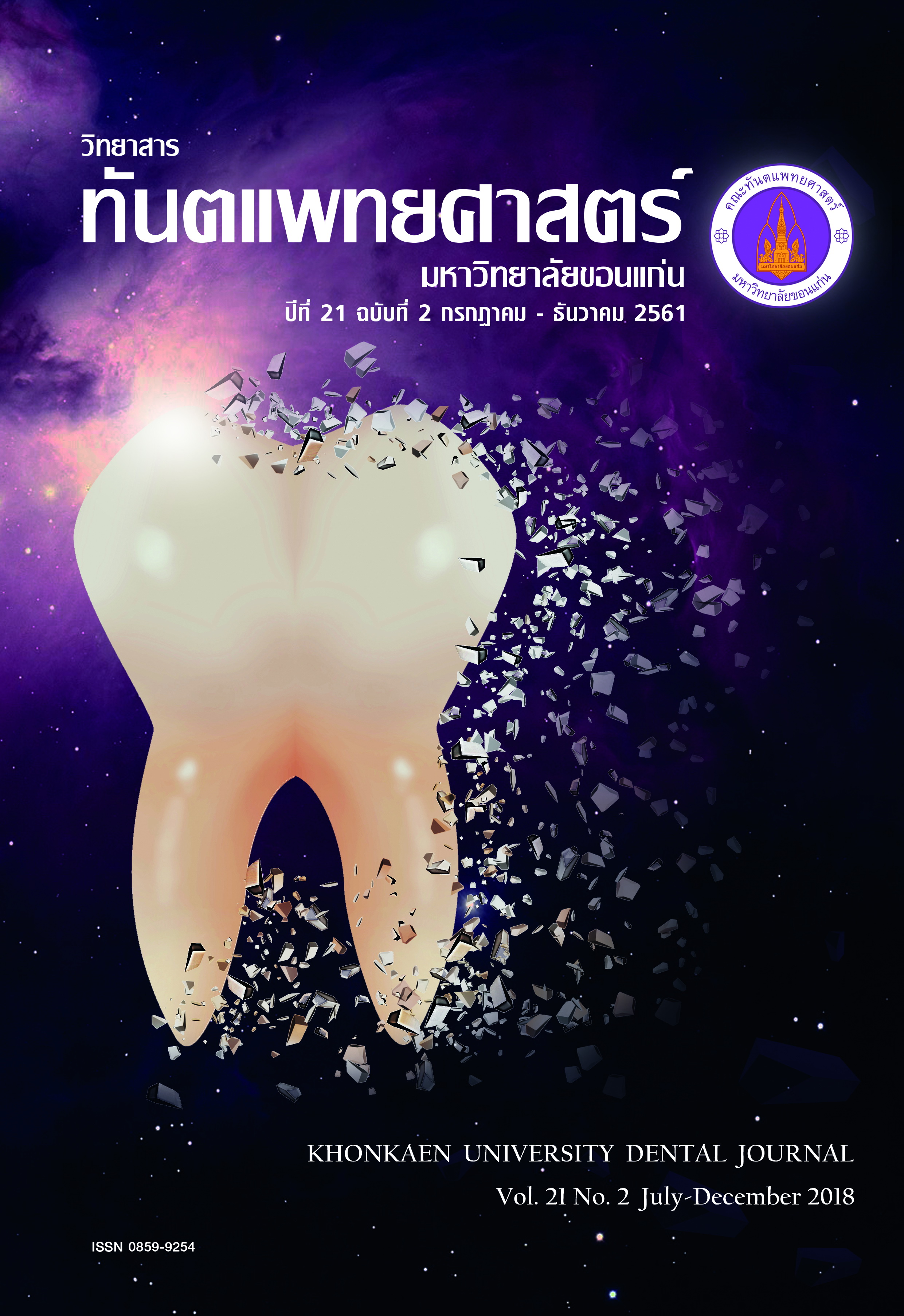การหายของแผลระหว่างผลิตภัณฑ์พรอพอลิสไทย และแคลเซียมไฮดรอกไซด์ ในการปิดทับเนื้อเยื่อในโดยตรงในแบบจำลองฟันมนุษย์ทั้งซี่: การศึกษานำร่อง
Main Article Content
บทคัดย่อ
การศึกษานี้เปรียบเทียบการหายของแผลระหว่างผลิตภัณฑ์พรอพอลิสไทยและแคลเซียมไฮดรอกไซด์ในการปิดทับเนื้อเยื่อในโดยตรง ในแบบจำลองฟันมนุษย์ที่เลี้ยงในอาหารเลี้ยงเซลล์ในห้องปฏิบัติการ โดยศึกษาในฟันกรามมนุษย์ซี่ที่สามจำนวน 13 ซี่ แบ่งเป็น กลุ่มควบคุม ลบ (3 ซี่) ได้แก่ ฟันที่ถูกถอนและศึกษาทันที (1 ซี่) ฟันที่ถูกถอนและเลี้ยงในห้องปฏิบัติการ 7 วัน (1 ซี่) และ 14 วัน (1 ซี่) กลุ่มควบคุม บวก (2 ซี่) ได้แก่ ฟันที่กรอทะลุเนื้อเยื่อในโดยไม่ปิดทับด้วยวัสดุใด ๆ และเลี้ยงในห้องปฏิบัติการ 7 วัน (1 ซี่) และ 14 วัน (1 ซี่) กลุ่มทดลอง 2 กลุ่ม ได้แก่ ฟันที่กรอทะลุเนื้อเยื่อในและปิดทับด้วยแคลเซียมไฮดรอกไซด์โดยเลี้ยงในห้องปฏิบัติการ 7 วัน (2 ซี่) และ 14 วัน (2 ซี่) และ ฟันที่กรอทะลุเนื้อเยื่อในและปิดทับด้วยผลิตภัณฑ์พรอพอลิสไทย โดยเลี้ยงในห้องปฏิบัติการ 7 วัน (2 ซี่) และ 14 วัน (2 ซี่) ผลทาง มิญชวิทยาพบ การอักเสบเรื้อรังในทุกกลุ่ม ยกเว้นไม่พบการอักเสบของฟันในกลุ่มควบคุมลบที่ถูกถอนและศึกษาทันที ฟันในกลุ่มควบคุมบวก ที่กรอทะลุเนื้อเยื่อในและไม่ปิดทับด้วยวัสดุใดๆที่เลี้ยงเป็นเวลา 7 วัน มีระดับการอักเสบมากกว่ากลุ่มอื่น ในกลุ่มทดลองฟันที่กรอทะลุเนื้อเยื่อ ในและปิดทับด้วยแคลเซียมไฮดรอกไซด์และผลิตภัณฑ์พรอพอลิสไทยที่เลี้ยงในห้องปฏิบัติการนาน 7 และ 14 วัน มีระดับการอักเสบไม่ แตกต่างกัน แต่ฟันที่ปิดทับด้วยผลิตภัณฑ์พรอพอลิสไทยที่เลี้ยงในห้องปฏิบัติการนาน 7 วัน ยังคงพบชั้นของเซลล์สร้างเนื้อฟันที่เรียงตัวอย่าง เป็นระเบียบและแนบกับชั้นเนื้อฟัน ในขณะที่ฟันที่ปิดทับด้วยแคลเซียมไฮดรอกไซด์มีการแยกกันของชั้นเซลล์สร้างเนื้อฟันออกจากเนื้อฟัน
Article Details
บทความ ข้อมูล เนื้อหา รูปภาพ ฯลฯ ทีได้รับการลงตีพิมพ์ในวิทยาสารทันตแพทยศาสตร์ มหาวิทยาลัยขอนแก่นถือเป็นลิขสิทธิ์เฉพาะของคณะทันตแพทยศาสตร์ มหาวิทยาลัยขอนแก่น หากบุคคลหรือหน่วยงานใดต้องการนำทั้งหมดหรือส่วนหนึ่งส่วนใดไปเผยแพร่ต่อหรือเพื่อกระทำการใด ๆ จะต้องได้รับอนุญาตเป็นลายลักษณ์อักษร จากคณะทันตแพทยศาสตร์ มหาวิทยาลัยขอนแก่นก่อนเท่านั้น
References
2. Kidd EA. Microleakage: a review. J Dent 1976;4:199-206.
3. Witherspoon DE. Vital pulp therapy with new materials: new directions and treatment perspectives--permanent teeth. J Endod 2008;34:S25-8.
4. Parirokh M, Torabinejad M. Mineral trioxide aggregate: a comprehensive literature review--Part III: Clinical applications, drawbacks, and mechanism of action. J Endod 2010;36:400-13.
5. Siripatarawan U, Vitchayakitti W, Sanguandeekul R. Antioxidant and antimicrobial properties of Thai propolis extracted using ethanotl aqueous solution. Int J Food Sci Tech 2013;48:24-7.
6. Banskota AH, Tezuka Y, Kadota S. Recent progress in pharmacological research of propolis. Phytother Res 2001;15:561-71.
7. Sforcin JM, Bankova V. Propolis: is there a potential for the development of new drugs? J Ethnopharmcol 2010; 133:253-60.
8. Parolia A, Thomas M, Kundabala M, Mohan M. propolis and its potential uses in oral health. Int J Med Med Sci 2010;2:210-5.
9. Wieckiewicz W, Miernik M, Wieckiewicz M, Morawiec T. Does propolis help to maintain oral health? Evid Based Complement Alternat Med 2013;2013:351062.
10. Phankhongsap A, Chailertvanitkul P, Juntavee A, Peerapattana J, Puasiri S. Effectiveness of root canal irrigant from mangosteen pericarp extracts with papain and propolis extracts with papain on mixture of Streptococcus gordonii and Enterococcus faecalis. J dent Assoc Thai 2014;64: 234-42.
11. Pengchum S, Chailertvanitkul P, Laopaiboon M, Thaweesit P, Abbott PV, Krisanaprakornkit S. Thai propolis extract as root canal medication against Enterococcus faecalis infection. Khon Kaen Dent J 2018;21:30-8.
12. Prueksakorn A, Puasiri S, Ruangsri S, Makeudom A, Sastraruji T, Krisanaprakornkit S, Chailertvanitkul P. The preservative effect of Thai propolis extract on the viability of human periodontal ligament cells. Dent Traumatol 2016;32:495-501.
13. Sabir A, Tabbu CR, Agustiono P, Sosroseno W. Histological analysis of rat dental pulp tissue capped with propolis. J Oral Sci 2005;47:135-8.
14. Parolia A, Kundabala M, Rao NN, Acharya SR, Agrawal P, Mohan M, et al. A comparative histological analysis of human pulp following direct pulp capping with Propolis, mineral trioxide aggregate and Dycal. Aust Dent J 2010;55:59-64.
15. Tecles O, Laurent P, Zygouritsas S, Burger AS, Camps J, Dejou J, et al. Activation of human dental pulp progenitor/ stem cells in response to odontoblast injury. Arch Oral Biol 2005;50:103-8.
16. Tecles O, Laurent P, Aubut V, About I. Human tooth culture: a study model for reparative dentinogenesis and direct pulp capping materials biocompatibility. J Biomed Mater Res B Appl Biomater 2008;85:180-7.
17. Chailertvanitkul P, Namsirikul T, Damrongrungruang T, Peerapattana J. Phenolic and flavonoids contents and antibacterial activity of ethanolic extract of propolis. Int J Pharm Sci 2017;13:59-67.
18. Aeinehchi M, Eslami B, Ghanbariha M, Saffar AS. Mineral trioxide aggregate (MTA) and calcium hydroxide as pulp-capping agents in human teeth: a preliminary report. Int Endod J 2003;36:225-31.
19. Asgary S, Eghbal MJ, Parirokh M, Ghanavati F, Rahimi H. A comparative study of histologic response to different pulp capping materials and a novel endodontic cement. Oral Surg Oral Med Oral Pathol Oral Radiol Endod 2008;106:609-14.
20. Magloire H, Joffre A, Bleicher F. An in vitro model of human dental pulp repair. J Dent Res 1996; 5:1971-8.
21. Aguilar P, Linsuwanont P. Vital pulp therapy in vital permanent teeth with cariously exposed pulp: a systematic review. J Endod 2011;37:581-7.
22. Olsson H, Petersson K, Rohlin M. Formation of a hard tissue barrier after pulp cappings in humans. A systematic review. Int Endod J 2006;39:429-42.

